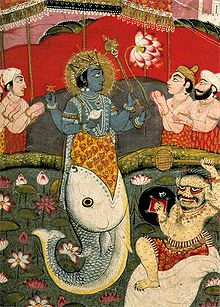Matsya
Matsya ( Sanskrit मत्स्य matsya m. "Fish") is a mythological fish in Hinduism and the first avatar of Vishnu . The Puranas report on it in different versions.
mythology
According to various narratives in the Puranas , the god Brahma sleeps for 4,320 million years from the end of a creation cycle until the beginning of the following cycle - a Brahma night. In one version it is the horse-headed demon Hayagriva who robbed him of the Vedas during this time , which he got back in his form as a fish with the help of Vishnu.
According to the Padma Purana , however, a demon named Shankhasura (also called Makara) stole the Vedas from Brahma during his long sleep. Because of this loss, people lost their righteousness over time and their lives were overshadowed by all kinds of vices. Brahma and the other Heavenly Ones prayed to Lord Vishnu for help. Shankhasura hid with the stolen Vedas in his underworld, at the bottom of the ocean, hidden in a conch shell called Panchajanya . Because of the requests, Vishnu appeared in the form of a large fish, Matsya, and killed the demon. Then he blew Shankhasura's conch horn and the sound of " Om " rang out , from which the Vedas returned, because without them Brahma would not have been able to recreate the worlds. Since then, the conch shell, one of the symbols of Vishnu, has been a visible sign of this victory. Brahma awoke and Vishnu - in the form of Matsya - gave him the Vedas. A new creation could begin.
After the Matsya-Purana and the Bhagavata-Purana , Vishnu in his fish incarnation saved the sage Manu in an ark from the flood and thereby saved the world from destruction. The story is about King Satyavrata Manu, who had practiced asceticism for thousands of years. When he tried to draw water in the river, a small fish swam into his hand. Just as he was about to throw him back into the water, the latter asked to save him from the dangers of the river. Manu put the fish in a small pot of water. But immediately it got bigger and the pot was too narrow. Manu threw the fish into a well where it continued to grow. So he brought him into a lake and ultimately into the ocean. King Satyavrata now realized that it must be Vishnu himself, who had taken the form of a fish. Thereupon Vishnu revealed: “O King, in seven days the three worlds will be flooded by the ocean of destruction. I will send you a huge boat. Until then, collect all kinds of herbs and seeds and get on the huge boat with the seven great rishis (sages Kashyapa , Atri , Vasishtha , Vishvamitra , Gautama , Jamadagni , Bharadvaja ) and all kinds of living beings. You will travel across the ocean of annihilation free from sorrow and only the light of the seven rishis will break the darkness. I always stay close to you, and when the boat is tossed back and forth by the storms, tie it to my horn with Vasuki (a giant mythical snake). I will pull the boat with you and the saints through the ocean of annihilation until Brahma awakens from his slumber. ” ( Bha 8.24.32-37) The fully grown fish avatar Matsya is described in the Bhagavatapurana as follows: “ While the king over meditating on the Lord, a large, golden shimmering fish with a horn appeared before him in the vast ocean of destruction. It was a million yojanas long (about 13 million kilometers). " ( Bha 8.24.44)
During the journey through the raging ocean, the fish Manu shared his teaching, which is the content of the Matsyapurana.
literature
- Peter and Anneliese Keilhauer: The Imagery of Hinduism. The Indian world of gods and their symbolism. DuMont, Cologne 1986, p. 78 ISBN 3-7701-1347-0
- Veronica Ions: Indian Mythology. Hamlyn Publishing, Rushden 1988, p. 48 ISBN 0-600-34285-9
Web links
Individual evidence
- ↑ Anneliese and Peter Keilhauer: The visual language of Hinduism. The Indian world of gods and their symbolism . DuMont, Cologne 1986, p. 78 ISBN 3-7701-1347-0
- ↑ Anneliese and Peter Keilhauer: The visual language of Hinduism. The Indian world of gods and their symbolism . DuMont, Cologne 1986, ISBN 3-7701-1347-0 , p. 78.
